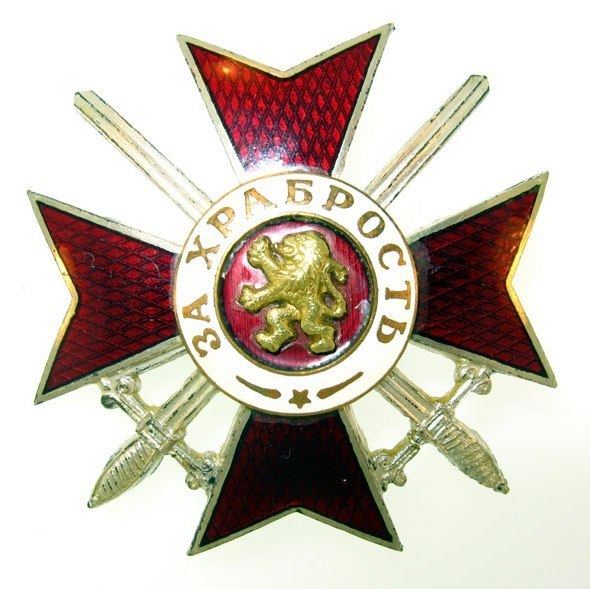 | ||
Orders, decorations and medals of Bulgaria are regulated by the law on the Orders and Medals of the Republic Of Bulgaria of 29 May 2003.
Contents
- Principality Of BulgariaThird Bulgarian Tsardom 29 April 1879 15 September 1946
- Unnoffical Medals
- Peoples Republic Of Bulgaria 16th September 1946 10th November 1989
- Republic Of Bulgaria 10th November 1989 29th May 2003
- Republic Of Bulgaria since 29 May 2003
- References
The National Military History Museum Of Bulgaria in Sofia currently has over 150 Bulgarian Orders in the collection, which it has acquired over 85 years in co-operation with the Bulgarian State Mint, which are in the main part imperial, including Orders awarded to Knjaz Alexander, Ferdinand and Tsar Boris III along with other high-ranking military leaders of the Royal Bulgarian Army.
Principality Of Bulgaria/Third Bulgarian Tsardom (29 April 1879 – 15 September 1946)
The decorations of the Principality Of Bulgaria (29 April 1879 – 5 October 1908) and the Third Bulgarian Tsardom (5 October 1908 – 15 September 1946) were divided into orders, medals and honorary insignia. Orders were awarded to civilians and military personnel for particularly great merits in service of the state (For example commanding an army to a victory). Honorary insignia (Badges) were awarded for a specific merit or achievement or due to a specific event (For example being wounded in action) and medals were presented on the occasion of a political or historic event or for merit (For example on the anniversary of independence). Most of the Imperial commemorative medals were only issued once, to participants at the commemorated event and only the highest level personnel could be expected to be at all these events during their term in high status society. No-one was issued every commemorative medal, as during the turbulence of coups, counter-coups and change of monarchs, the high level society was in near constant change.
The Principality Of Bulgaria's first order was created with Article 59 of the Tarnovo Constitution, The Order Of Bravery, which came into force on 1 January 1880 (The order itself shows the date 1879 on the reverse). The highest Tsardom Of Bulgaria award was the Order Of Saint Cyril And Saint Methodius awarded to those who brought outstanding excellence to the culture of the Tsardom Of Bulgaria (The People's Republic Of Bulgaria also created an Order of the same title in three classes but that was a far lower level award for merit in education and science and is not to be confused).
Unnoffical Medals
These "medals" were "issued" or "awarded" by various groups and organisations including government departments but were/are not fully recognised as officially awarded medals and were/are not authorised for official wear on official uniforms. That being so this does not mean by any means that these medals were simply just for sale to all comers and were/are still often held in high respect by those who were given them.
People's Republic Of Bulgaria (16th September 1946-10th November 1989)
With the exile of Tsar Simeon II all Imperial Bulgarian awards were discontinued and banned (Other than those created after the pro-soviet coup of 4 September 1944), including the wear of such awards. Traces of the Imperial award system were left in the following ways;
Republic Of Bulgaria (10th November 1989-29th May 2003)
With the collapse of The People's Republic Of Bulgaria their award system was discontinued (Officially on 5 April 1991) with the exception of orders bestowed on foreign nationals. All communist and imperial awards were allowed to be worn. The soviet style 5 sided suspension was dropped, with the exception of the medal 50th Anniversary Of Victory Over Hitler's Fascism, which had a 5 sided enamel suspension and the Imperial tradition of different ribbons for different sexes were reintroduced for certain awards. Between 5 April 1991 and the introduction of The Order For Loyal Service Under The Banner in 1994 there were no official state awards for Bulgarian citizens. As of 29 May 2003 a totally new award system was introduced and as of the 9 June 2003 the previous system was officially abolished.
Republic Of Bulgaria (since 29 May 2003)
Legal organisation of the current Bulgarian Honours System is contained in the Constitution and the Decree on Intellectual Stimulation. Orders are established by the National Assembly and are awarded by the President of the Republic. The nomination of a foreign person is made by the Ministry of External Affairs, whereas Bulgarian nominees are selected by the Council of Ministers.
